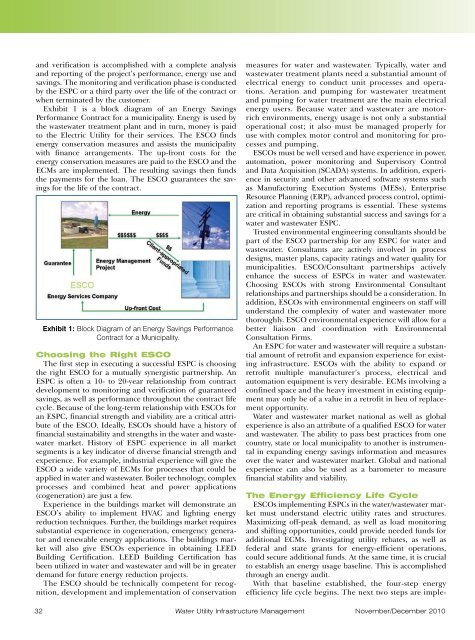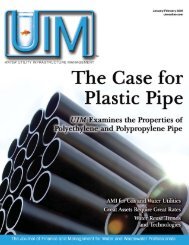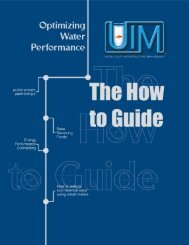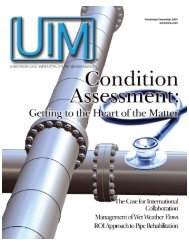Download - Water Utility Infrastructure Management
Download - Water Utility Infrastructure Management
Download - Water Utility Infrastructure Management
Create successful ePaper yourself
Turn your PDF publications into a flip-book with our unique Google optimized e-Paper software.
and verification is accomplished with a complete analysisand reporting of the project’s performance, energy use andsavings. The monitoring and verification phase is conductedby the ESPC or a third party over the life of the contract orwhen terminated by the customer.Exhibit 1 is a block diagram of an Energy SavingsPerformance Contract for a municipality. Energy is used bythe wastewater treatment plant and in turn, money is paidto the Electric <strong>Utility</strong> for their services. The ESCO findsenergy conservation measures and assists the municipalitywith finance arrangements. The up-front costs for theenergy conservation measures are paid to the ESCO and theECMs are implemented. The resulting savings then fundsthe payments for the loan. The ESCO guarantees the savingsfor the life of the contract.Exhibit 1: Block Diagram of an Energy Savings PerformanceContract for a Municipality.Choosing the Right ESCOThe first step in executing a successful ESPC is choosingthe right ESCO for a mutually synergistic partnership. AnESPC is often a 10- to 20-year relationship from contractdevelopment to monitoring and verification of guaranteedsavings, as well as performance throughout the contract lifecycle. Because of the long-term relationship with ESCOs foran ESPC, financial strength and viability are a critical attributeof the ESCO. Ideally, ESCOs should have a history offinancial sustainability and strengths in the water and wastewatermarket. History of ESPC experience in all marketsegments is a key indicator of diverse financial strength andexperience. For example, industrial experience will give theESCO a wide variety of ECMs for processes that could beapplied in water and wastewater. Boiler technology, complexprocesses and combined heat and power applications(cogeneration) are just a few.Experience in the buildings market will demonstrate anESCO’s ability to implement HVAC and lighting energyreduction techniques. Further, the buildings market requiressubstantial experience in cogeneration, emergency generatorand renewable energy applications. The buildings marketwill also give ESCOs experience in obtaining LEEDBuilding Certification. LEED Building Certification hasbeen utilized in water and wastewater and will be in greaterdemand for future energy reduction projects.The ESCO should be technically competent for recognition,development and implementation of conservationmeasures for water and wastewater. Typically, water andwastewater treatment plants need a substantial amount ofelectrical energy to conduct unit processes and operations.Aeration and pumping for wastewater treatmentand pumping for water treatment are the main electricalenergy users. Because water and wastewater are motorrichenvironments, energy usage is not only a substantialoperational cost; it also must be managed properly foruse with complex motor control and monitoring for processesand pumping.ESCOs must be well versed and have experience in power,automation, power monitoring and Supervisory Controland Data Acquisition (SCADA) systems. In addition, experiencein security and other advanced software systems suchas Manufacturing Execution Systems (MESs), EnterpriseResource Planning (ERP), advanced process control, optimizationand reporting programs is essential. These systemsare critical in obtaining substantial success and savings for awater and wastewater ESPC.Trusted environmental engineering consultants should bepart of the ESCO partnership for any ESPC for water andwastewater. Consultants are actively involved in processdesigns, master plans, capacity ratings and water quality formunicipalities. ESCO/Consultant partnerships activelyenhance the success of ESPCs in water and wastewater.Choosing ESCOs with strong Environmental Consultantrelationships and partnerships should be a consideration. Inaddition, ESCOs with environmental engineers on staff willunderstand the complexity of water and wastewater morethoroughly. ESCO environmental experience will allow for abetter liaison and coordination with EnvironmentalConsultation Firms.An ESPC for water and wastewater will require a substantialamount of retrofit and expansion experience for existinginfrastructure. ESCOs with the ability to expand orretrofit multiple manufacturer’s process, electrical andautomation equipment is very desirable. ECMs involving aconfined space and the heavy investment in existing equipmentmay only be of a value in a retrofit in lieu of replacementopportunity.<strong>Water</strong> and wastewater market national as well as globalexperience is also an attribute of a qualified ESCO for waterand wastewater. The ability to pass best practices from onecountry, state or local municipality to another is instrumentalin expanding energy savings information and measuresover the water and wastewater market. Global and nationalexperience can also be used as a barometer to measurefinancial stability and viability.The Energy Efficiency Life CycleESCOs implementing ESPCs in the water/wastewater marketmust understand electric utility rates and structures.Maximizing off-peak demand, as well as load monitoringand shifting opportunities, could provide needed funds foradditional ECMs. Investigating utility rebates, as well asfederal and state grants for energy-efficient operations,could secure additional funds. At the same time, it is crucialto establish an energy usage baseline. This is accomplishedthrough an energy audit.With that baseline established, the four-step energyefficiency life cycle begins. The next two steps are imple-32 <strong>Water</strong> <strong>Utility</strong> <strong>Infrastructure</strong> <strong>Management</strong>November/December 2010








